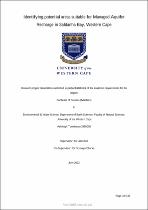| dc.contributor.advisor | Nel, Jaco | |
| dc.contributor.author | Tomlinson, Ashleigh | |
| dc.date.accessioned | 2022-07-08T08:18:37Z | |
| dc.date.available | 2022-07-08T08:18:37Z | |
| dc.date.issued | 2022 | |
| dc.identifier.uri | http://hdl.handle.net/11394/9156 | |
| dc.description | >Magister Scientiae - MSc | en_US |
| dc.description.abstract | The West Coast in the Western Cape of South Africa is a water-scarce area. Pressure from population
and industrial growth, recurring droughts and climate change has resulted in an increasing urgency in
the West Coast to increase the available water resources. Saldanha Bay is dependent on both surface
water and groundwater as part of its bulk water supply system for domestic, agricultural and industrial
purposes. Where the natural groundwater recharge is no longer sufficient to meet the growing
groundwater needs, practices such as Managed Aquifer Recharge can be used to improve the
sustainability of these groundwater resources. The Lower Berg aquifer systems, focusing on the
Langebaan Road and Hopefield wellfields, were evaluated to determine whether Managed Aquifer
Recharge systems could be implemented nearby to improve the sustainability of this scarce water
resource. | en_US |
| dc.language.iso | en | en_US |
| dc.publisher | University of the Western Cape | en_US |
| dc.subject | Groundwater sustainability | en_US |
| dc.subject | Aquifer | en_US |
| dc.subject | Geophysics | en_US |
| dc.subject | Western Cape | en_US |
| dc.subject | Climate change | en_US |
| dc.title | Identifying potential areas suitable for managed aquifer recharge in Saldanha bay, Western Cape | en_US |
| dc.rights.holder | University of the Western Cape | en_US |

